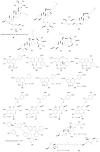Development and Structural Modification of BACE1 Inhibitors
- PMID: 28025519
- PMCID: PMC6155942
- DOI: 10.3390/molecules22010004
Development and Structural Modification of BACE1 Inhibitors
Abstract
Alzheimer's disease (AD) is a progressive neurodegenerative disorder which usually occurs in the elderly. The accumulation of β-amyloid and the formation of neurofibrillary tangles are considered as the main pathogenies of AD. Research suggests that β-secretase 1 (BACE1) plays an important role in the formation of β-amyloid. Discovery of new BACE1 inhibitors has become a significant method to slow down the progression of AD or even cure this kind of disease. This review summarizes the different types and the structural modification of these new BACE1 inhibitors.
Keywords: Alzheimer’s disease; BACE1; BACE1 inhibitors; structural modification; β-amyloid.
Conflict of interest statement
The authors declare no conflict of interest.
Figures











References
-
- Zhao X.S., Peng J., Wu Q., Ren Z., Pan L.H., Tang Z.H., Jiang Z.S., Wang G.X., Liu L.S. Imbalanced cholesterol metabolism in Alzheimer’s disease. Clin. Chim. Acta. 2016;456:107–114. - PubMed
-
- Awasthi M., Singh S., Pandey V.P., Dwivedi U.N. Alzheimer’s disease: An overview of amyloid beta dependent pathogenesis and its therapeutic implications along with in silico approaches emphasizing the role of natural products. J. Neurol. Sci. 2016;361:256–271. doi: 10.1016/j.jns.2016.01.008. - DOI - PubMed
Publication types
MeSH terms
Substances
LinkOut - more resources
Full Text Sources
Other Literature Sources
Medical

